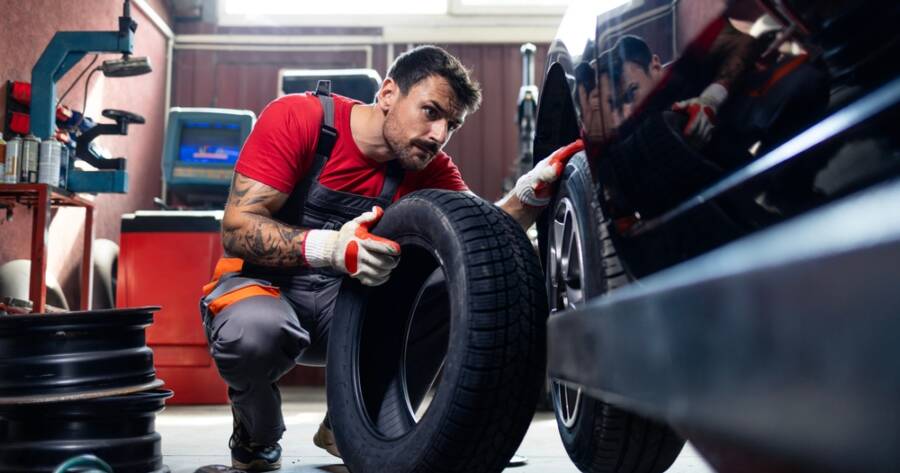Your tires are the only part of your car that makes direct contact with the road, making them crucial for safety and performance. Worn-out tires can lead to poor handling, longer stopping distances, and an increased risk of blowouts. Knowing when it’s time for a new set not only keeps you safe but also saves money in the long run. From checking tread depth to choosing the right replacement, understanding tire health is a must for every driver.
Check Tread Depth: The Penny Test Never Fails
One of the simplest ways to check tire wear is the penny test. Place a penny head-first into the tire tread. If you can see the top of Lincoln’s head, it’s time for new tires. Ideally, your tread depth should be at least 2/32 of an inch, but for better safety and performance, many experts recommend replacing them when they reach 4/32 of an inch.
Tread depth affects your car’s ability to grip the road, especially in wet or snowy conditions. Worn-out treads can cause hydroplaning and reduce braking efficiency. If your tires are near or below the recommended depth, start planning for replacements. Investing in new tires early can prevent accidents and maintain optimal performance.
Look for Uneven Wear Patterns
Tires don’t always wear evenly, and that can signal alignment issues or improper inflation. Check your tires for signs of cupping (dips in the tread), feathering (tread that feels smooth in one direction but rough in the other), or balding on one edge. Uneven wear means your tires aren’t making proper contact with the road, compromising your safety.
If you spot unusual patterns, get your alignment and suspension checked. Sometimes, rotating your tires regularly can prevent uneven wear, but once the damage is done, it’s hard to reverse. Replacing tires affected by uneven wear ensures that your car handles properly and brakes effectively, especially on slick roads.
Pay Attention to Seasonal Needs
Not all tires are suitable year-round. If you live in an area with harsh winters, switching to winter tires before the first snowfall is crucial. These tires are made from softer rubber that stays flexible in cold temperatures, offering better traction. On the flip side, summer tires perform best in warm, dry conditions, but can become brittle and less effective when temperatures drop.
All-season tires are a good compromise for moderate climates, but they may not perform as well in extreme conditions. Think about your driving habits and local weather before investing in a new set. Seasonal readiness is key to staying safe and keeping your car in optimal shape all year long.
Know the Signs of Tire Aging
Even if your tires look fine, they may be aging out. Rubber deteriorates over time, especially when exposed to sunlight, heat, and rough road conditions. Cracks on the sidewalls, discoloration, or visible dry rot are red flags. Most manufacturers recommend replacing tires every six to ten years, regardless of tread condition.
Check your tire’s date code, usually printed on the sidewall as a four-digit number. The first two digits represent the week of manufacture, and the last two represent the year. If your tires are nearing a decade in age, it’s best to replace them—even if they haven’t logged many miles.
Budget-Friendly Tips for Buying New Tires
Tires can be pricey, but shopping smart helps you get the most value for your money. Start by identifying the right size and type for your vehicle. Check your car’s manual or the tire placard on the driver’s side door for specifications. Consider your typical driving conditions when deciding between all-season, performance, or winter tires.
Shop around at local stores and online retailers. Look for sales, rebates, or package deals that include installation. Don’t shy away from reputable discount brands if they meet safety standards. Investing a bit of time to compare options can save you hundreds without sacrificing quality or safety.
Take Care of Your Investment with Proper Maintenance
Once you’ve purchased new tires, keeping them in top shape is essential. Regular tire rotations every 6,000 to 8,000 miles help distribute wear evenly. Keep your tires inflated to the recommended pressure, usually listed in your owner’s manual or on the inside of your driver’s door. Under-inflated tires wear out faster and decrease fuel efficiency.
Also, don’t forget to balance and align your wheels as part of routine maintenance. Misaligned wheels can cause uneven wear, making your new investment last far shorter than intended. Regular check-ups and mindful driving habits help maximize your tire lifespan and maintain smooth, safe driving.
Drive with Confidence on the Right Tires
Knowing when to replace your tires is more than just a maintenance task–it’s a safety precaution. From checking tread depth to spotting signs of wear and choosing the right type for your climate, staying proactive keeps you and your passengers secure.
Investing in quality tires and maintaining them properly means fewer surprises on the road and more confident driving. Don’t wait for a flat or a blowout to remind you. It’s better to be prepared than stranded!

